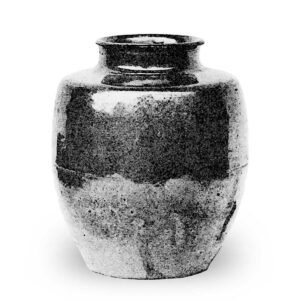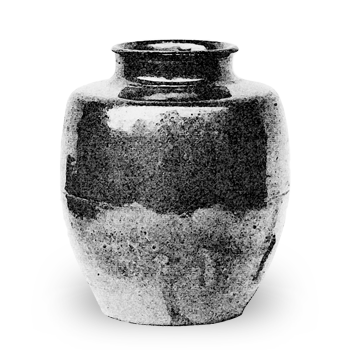
A great masterpiece. A tea caddy by Han. Zenji Dogen, the founder of Eiheiji Temple (son of Kuga Dainagon Michichika), accompanied by Seto potter Fujishiro (Kato Keisho), entered Tang Dynasty China and brought back a tea caddy from his return to Japan during the Anjeong period (1227-19), which was presented to the Kuga Dainagon family. The mouth is shallowly twisted, and there are small yellow dots scattered like stars in the ame-iro glaze. The chinkuji line around the body is partially broken in some places. The bottom of the bowl has been worn away by the shingle and there are also some hand-slip marks on the entire body, indicating the age of the bowl. The mouth is glazed all over, and there is also a single streak that runs down to the bottom edge, and the bottom is also glazed in some places. The shape and color of the glaze are both elegant and beautiful, and this is one of the best tea containers made in China. After the Kuga Dainagon family, it passed through Sosan Hikouemon, Hariya Shouchin in Kyoto, and Oda Nobunaga to Muneyoshi (also known as Muneyoshi) in Bungo Province (Oita Prefecture), who presented it to Toyotomi Hideyoshi. On March 11, 1697, Shogun Tsunayoshi gave it to Yanagisawa Dewamori Yoshiyasu, lord of Koriyama Castle in Yamato Province (Nara Prefecture), and it remained in the Matsuura family for a long time. After the Meiji Restoration, it passed through a wealthy merchant in Fushimi and a samurai family in Obama to the Matsuura family. (Higashiyama Gomotsu Nai-betsu-cho, Tsuda Munenori Chayu Nikki, Yamagami Souji Ki, Chakki Meimono Shu, Meimono Chou, Gomotsu Gozuki, Seto Toki Rabinokuchi, Kokin Meimono Ruiju, Komeimono Ki, Rimpo Kameryu, Manpou Zensho, Taisho Meiki Kan, etc.)



